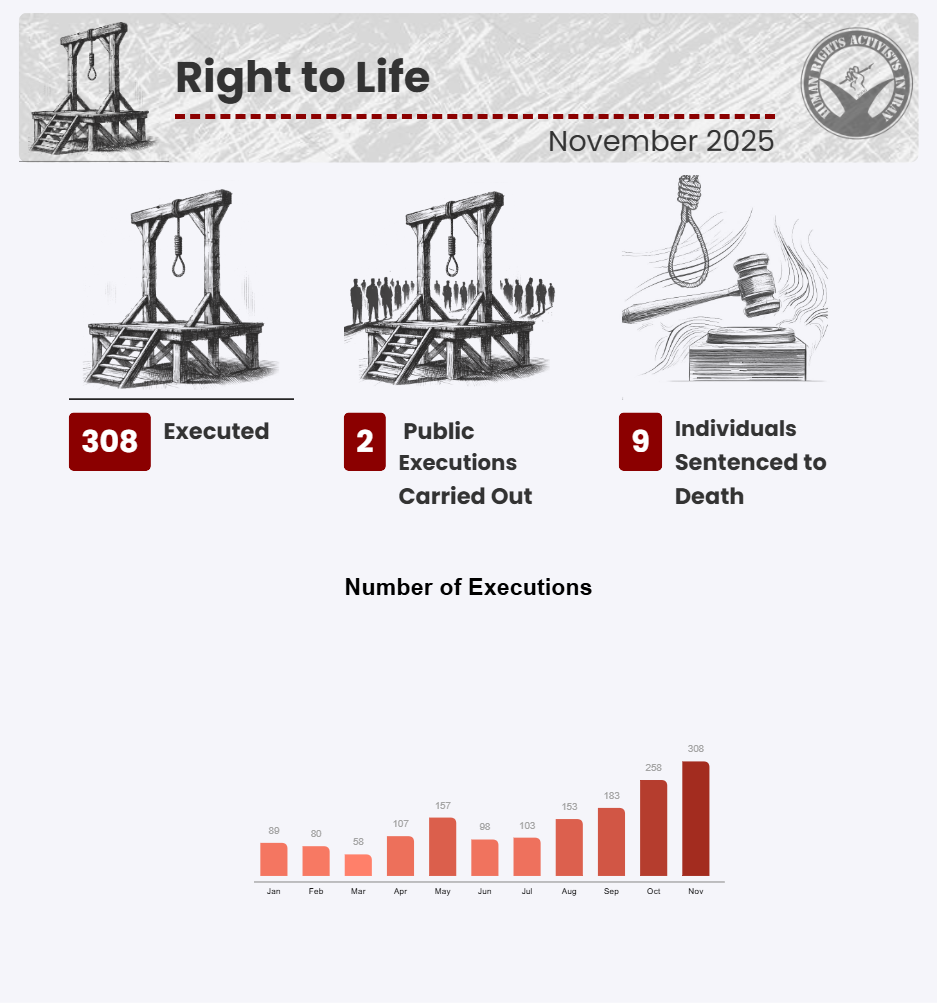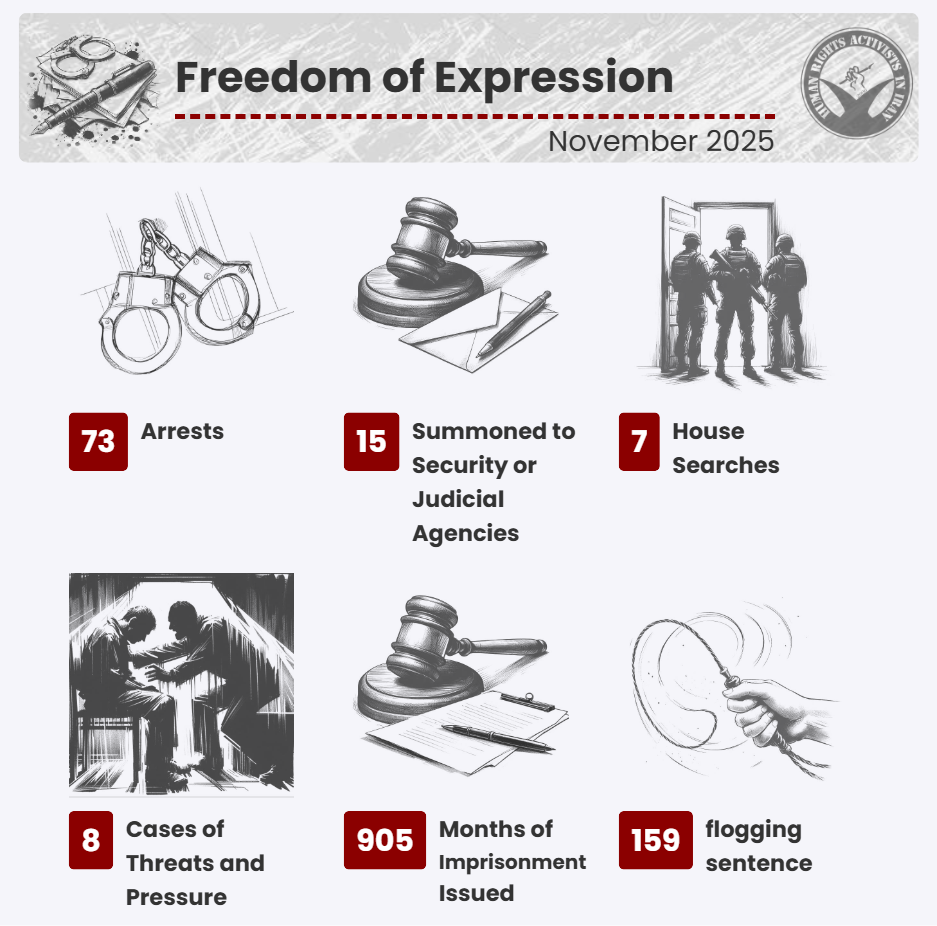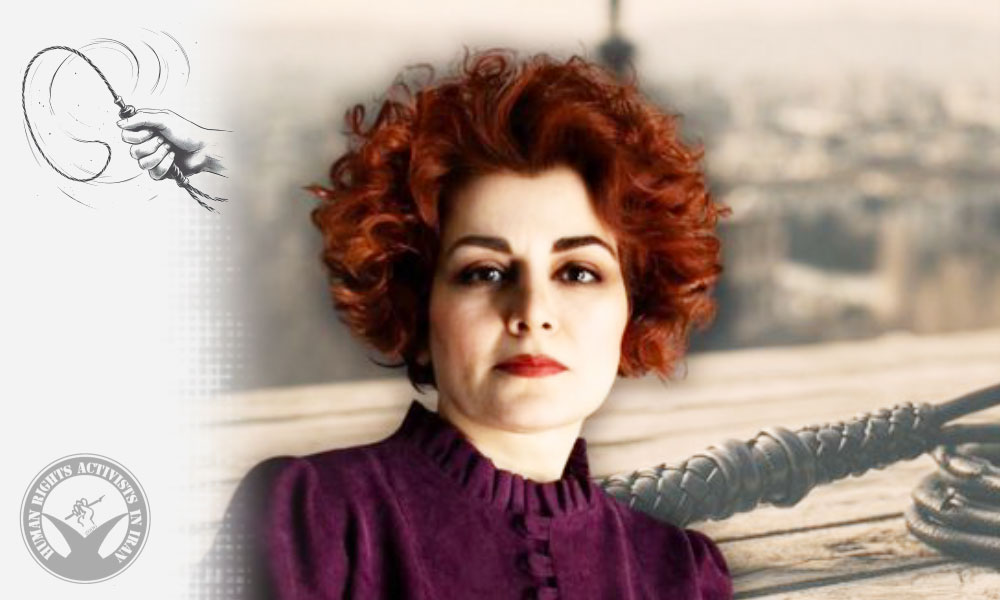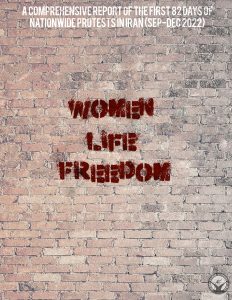HRANA- This report provides a summary of numerous human rights violations in Iran during November 2025. An unprecedented surge in executions, a rise in the arrests of citizens for expressing opinion and belief, and the extraction of forced confessions from detainees and prisoners were among the most significant human rights violations of the past month.
Executions
In November, 308 individuals were hanged in Iranian prisons, mostly on drug-related and murder charges. This brought the number of executions this year to an unprecedented 1,594.
Among those executed were seven women. The gender of another 52 individuals remains unknown, reflecting the Iranian regime’s lack of transparency in releasing information.
Two executions were carried out in public, and seven of those executed were Afghan nationals.
The charges against 161 of those executed were murder, and 137 were related to drugs. Five individuals were executed on charges of rape, and the charges for another five remain unknown.
HRANA has also reported the issuance of nine death sentences on charges of murder. Two of those sentenced to death are women. Also, the death sentences of Masoud Jamaei, Alireza Mardasi, and Farshad Etemadifar, political prisoners held in Sheiban Prison in Ahvaz, were upheld by the Supreme Court.

Freedom of Thought and Expression
In the past month, the Iranian regime’s security agencies arrested 73 individuals for expressing their opinions and beliefs. In eleven of these arrests, security forces did not present an arrest warrant. The most prominent example was the detention of fourteen individuals for protest-related activities such as writing protest slogans. These citizens were subjected to forced confessions and accused of having connections abroad. Four people were summoned by security agencies, and eleven others were summoned by judicial authorities. The homes of seven citizens were searched by security forces.
This month, 16 individuals were also tried for expressing their opinions and beliefs. A total of 25 people were sentenced to 905 months of imprisonment. In addition, the Iranian judiciary issued a sentence of 159 lashes. The sentence of 38 lashes against Atash (Zahra) Shakarami, on the charge of “spreading falsehoods,” was also carried out. She is the aunt of Nika Shakarami, one of those killed during the 2022 nationwide protests.

Prisoners’ Rights
The rights of prisoners, especially political and ideological prisoners, are being violated in various ways. In this month alone, 21 cases of denial of adequate medical care for political and ideological prisoners, including Zeinab Jalalian, the only female political prisoner in Iran sentenced to life imprisonment, 25 cases of transferring prisoners to solitary confinement, and 5 cases of prolonged solitary confinement were recorded.
HRANA reported 67 cases of detainees being held in a state of uncertainty, 40 cases in which families of detainees were not informed of their status after their arrest, and 15 cases of forced confessions.
Due to harsh prison conditions, five cases of prisoner suicide, three deaths caused by illness, and ten hunger strikes were documented.
Additionally, six cases of denial of visitation rights and 20 cases of denial of access to legal counsel were recorded.

Kolbars and Fuel Carriers
Each week, a number of citizens fall victim to the unregulated shootings carried out by military and law-enforcement forces. This month, these shootings claimed the lives of eight citizens and injured five others. Four fuel carriers (sookhtbar) were among those killed, and two fuel carriers and one kolbar were among the injured.
Additionally, due to the explosion of a landmine left over from the Iran–Iraq war, a 40-year-old kolbar named Ebrahim Abdollahi was maimed in the border areas of Nowsud.
Workers’ Rights
In November, 116 labor protests and nine labor strikes were reported, and two labor activists were arrested.
Workplace incidents also claimed the lives of 44 workers and injured 96 others. In addition, a firefighter in Sanandaj attempted self-immolation.
HRANA’s reports this month documented wage arrears affecting 7,886 workers.
Unions and professional guilds also held 100 protest gatherings. Another tragic case was the self-immolation and death of Ahmad Baladi, a 20-year-old student from Ahvaz, in protest against the municipality’s demolition of his family’s kiosk.
HRANA also reported the sealing of 18 commercial establishments, including cafés and traditional eateries.
Additionally, the Iranian judiciary issued eight rulings against union and guild activists, amounting in total to 43 months of imprisonment, sixty months of exile, and four cases of deprivation of social rights.
Women’s Rights
In the past month, HRANA recorded the murders of nine women, including a report about a man in Urmia County who shot and killed his mother, his sister, and his wife’s mother. After the killings, the suspect took his own life in the presence of his young child.
For further statistical details on violence against women over the past twelve months, refer to the HRANA report published in November.
Children’s Rights
Cases of violations against children this month included the murder of two children, one case of a victim of physical violence and abuse, the suicide of a fourteen-year-old teenager in Gachsaran, and one case of sexual assault and abuse. The death of a thirteen-year-old child laborer in Isfahan was also reported.
Additionally, the death of one child and injuries to 104 others due to official negligence were recorded, along with two abandoned newborns.
Religious Minorities
In this month, Iranian courts sentenced four members of religious minorities to a total of 160 months of imprisonment, including the conviction of Shahram Fallah, a Baha’i citizen, to nine and a half years in prison and one year of exile by the Court of Appeal. Three sentences involving social deprivations and two travel bans were also issued against members of religious minorities.
The prison sentences of twelve members of religious minorities, including seven individuals from the Baha’i community and two Christian converts, were carried out. The homes of six members of religious minorities were also searched this month and six people were arrested.
Ethnic Rights
In November, the Iranian regime’s security forces arrested thirteen ethnic rights activists and carried out one home search. In ten of these cases, the forces did not present an arrest warrant.
Inhuman Punishment







